From Lucerne to Locarno: By Train Across the Gotthard
This review details my train journey from Lucerne to Locarno, traversing the scenic Gotthard Line across the Swiss Alps.
From Lucerne to Locarno by train
After spending some time in the charming city of Lucerne, it was time for me to move on to my next destination in Switzerland.
From Lucerne, I needed to travel south by train across the Gotthard Massif of the Swiss Alps to Locarno, where I had booked my accommodation for the night.
With a bit of luck, I could reach Locarno before nightfall, allowing me to enjoy some of the scenery along the railway line.
I was quite excited to travel, as the Gotthard line is considered one of the most scenic railway lines in Switzerland.
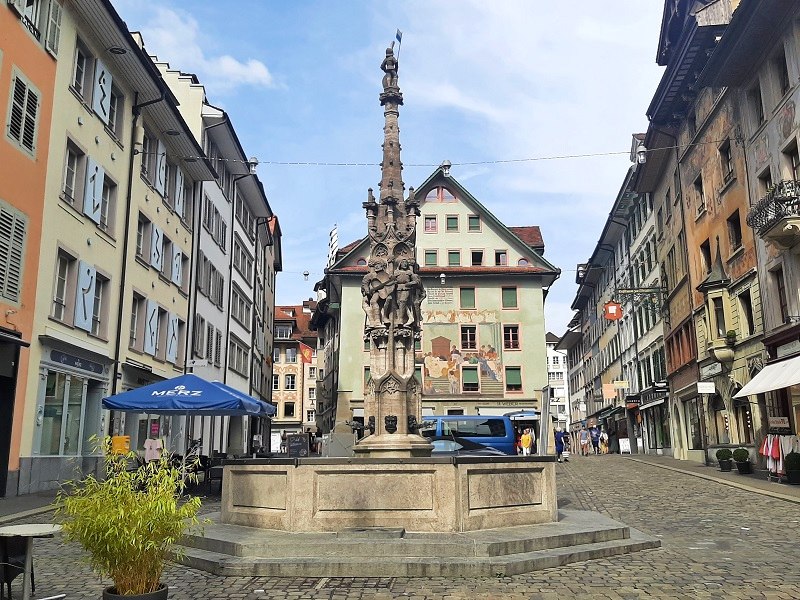

Crossing the Gotthard by train
The Gotthard railway line is one of the main north-south arteries across the Swiss Alps, if not the most important.
This railway line connects the German-speaking cantons north of the Alps with the Italian-speaking canton of Ticino in the south of Switzerland, crossing the border into Italy at Chiasso, from where it extends further south towards Como and Milan.
There are actually two distinct rail routes across the Gotthard, both of which are part of the same Gotthard railway line.
The classic railway line runs south from Arth-Goldau towards Göschenen, where it enters a 15-kilometre-long (9.3-mile) tunnel built in 1882, emerging again in Airolo on the southern side of the Alps, and continuing towards Bellinzona.
It’s a highly scenic route, with many spiral loops, high viaducts, and tunnels designed to overcome the significant elevation differences and challenging mountainous terrain.
Needless to say, the twisty nature of this railway line and its steep gradient mean that trains traversing the classic Gotthard line travel at relatively slow speeds.
To reduce travel times along this railway line and increase capacity for freight traffic, the Swiss decided to build a new tunnel through the Gotthard Massif, bypassing the most mountainous and slowest sections of the old line.
Named the Gotthard Base Tunnel, this 57-kilometre-long (35.5-mile) tunnel opened for rail traffic in 2016.
All the fast InterCity (IC) and EuroCity (EC) passenger trains use the line through the Gotthard Base Tunnel, while InterRegio (IR) trains continue to use the slower but more scenic classic railway line.
As I had some time on my hands, I decided to cross the Gotthard on one of the slower InterRegio trains that traverse the classic railway line.
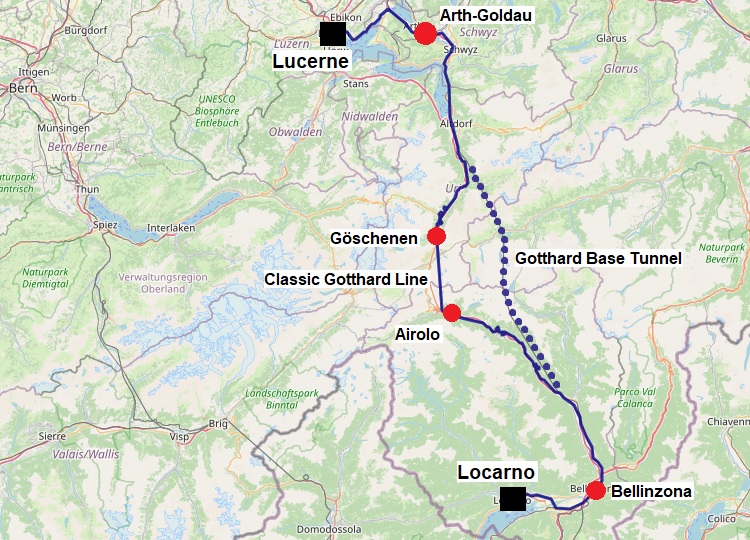
Booking your ticket
You can look up train timetables and buy your ticket online on the website of Swiss national railway company SBB, or use third-party booking website Omio.
If you want to travel across the classic Gotthard line but don’t see InterRegio trains in the search results, try entering Airolo in the ‘via’ field.
This will prompt the search engine to exclude trains using the Gotthard Base Tunnel.
When booking your ticket through the Swiss Federal Railways, be aware that their website will automatically assume you have a half fare travelcard (‘halbtax’), which provides a 50% discount and is held by most Swiss residents.
If you don’t have a discount card, you need to turn off this setting to see full-fare tickets.
Because of this, some foreign tourists find Omio’s search engine more user-friendly, as it offers train tickets at the same price and accepts all debit and credit cards.
If you are travelling with an Interrail or Eurail pass, you can board any InterRegio (IR) or InterCity (IC) train you wish across the Gotthard, as seat reservations are not compulsory.
When taking one of the EuroCity (EC) trains across the Gotthard, you should note that reservations are optional for domestic journeys within Switzerland, but compulsory if you are travelling onwards to or from Italy.
Therefore, you don’t necessarily need a seat reservation when travelling solely on an EuroCity train from Zurich to Bellinzona, but you do need one if you travel on the same train from Zurich to Como or Milan.
When booking a full-price EuroCity train ticket between Switzerland and Italy, the seat reservation will automatically be included with your ticket.
The compulsory seat reservation for Interrail/Eurail passholders on EuroCity trains between Switzerland and Italy costs €13 regardless of travel class and can be best booked online through Rail Europe by clicking on “add rail pass”, selecting the Eurail or Interrail pass you have, and then searching for your route.
Lucerne railway station
Back to my own journey, which began at Lucerne’s railway station.
Although English-speaking people (as well as the French) refer to the city as Lucerne, its name in the German language, spoken in this part of Switzerland, is Luzern.
Luzern is also the name you’ll find on all station signs and in most railway timetables.
In front of Luzern station, you can see the original arch from the old railway station, which tragically burned down in a large fire in 1971.
Sadly, most of what was once a cathedral-like railway station has been replaced by a rather ugly glass-and-concrete structure, although the train shed itself remains impressive in its dimensions.

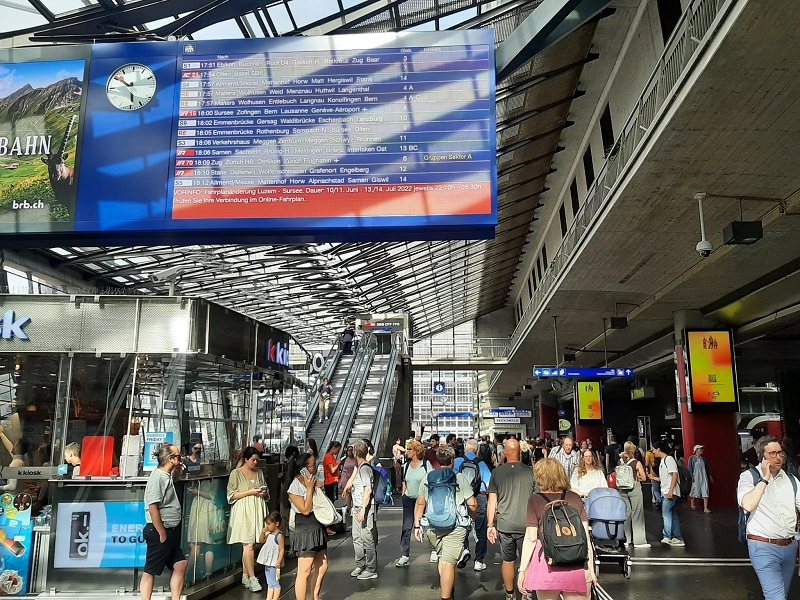

On the Lucerne to Arth-Goldau train
There are direct InterCity (IC) trains connecting Lucerne across the Gotthard to Bellinzona and Lugano.
I could have easily taken one of these trains, which would have provided a straightforward one-stop connection from Lucerne to Locarno with a simple change of trains in Bellinzona.
However, these Lucerne-Bellinzona IC trains use the new Gotthard base tunnel rather than the classic line – ideal if speed is your top priority, but less so if you prefer a more scenic journey.
I therefore decided to do things differently and first take a train to Arth-Goldau, where I could connect to an InterRegio train heading south across the classic Gotthard line.
Lucerne is connected to Arth-Goldau by frequent InterCity and S-Bahn (S) trains, with the latter being local services that stop at every station along the route.
Since the first train to depart was an S-Bahn service, I took that one to get to Arth-Goldau.
On these Swiss S-Bahn trains, seats in both second and first class are arranged in a 2+2 configuration.

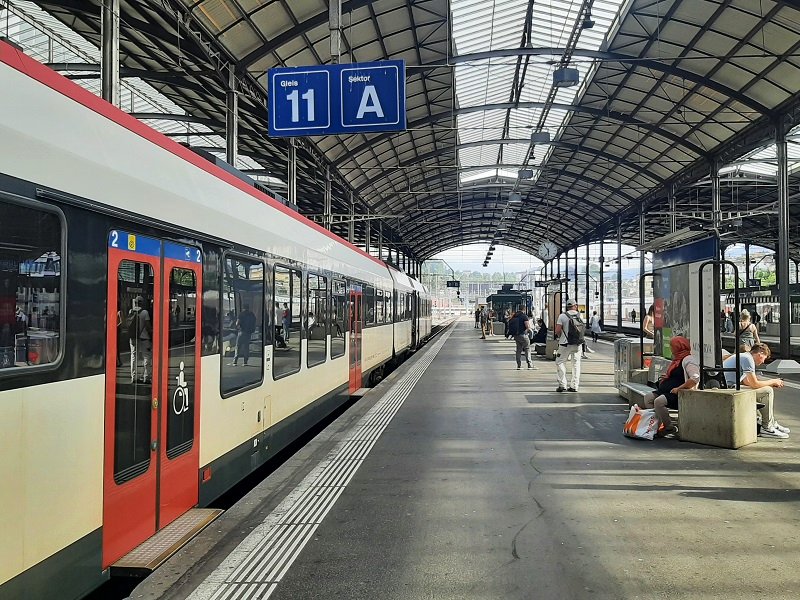
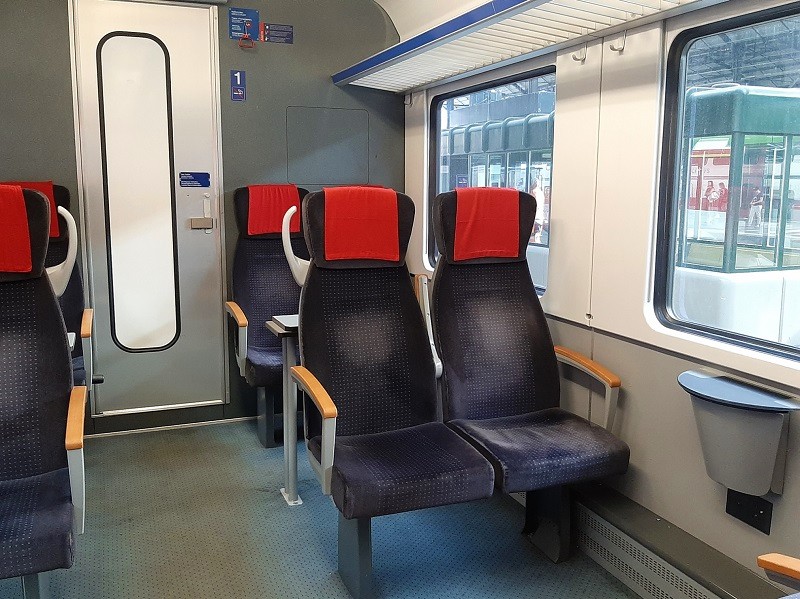
Lucerne to Arth-Goldau by S-Bahn Train
Train S 21369 – Departure: 6.06pm – Arrival: 6.38pm
Duration: 0h32m – Distance: 28 kilometres
The journey from Lucerne to Arth-Goldau
Although the train journey from Lucerne to Arth-Goldau is short, it’s actually quite a scenic ride.
Shortly after departure, the train crosses the bridge over the River Reuss, offering views of the old town of Lucerne and the city walls.
One of the stations where this S-Bahn train stops is Luzern Verkehrshaus, which is located right next to Lucerne’s excellent transport museum.
The train then runs along the shore of Lake Lucerne, stopping in towns like Küssnacht, which is perhaps most famous as the site where Belgian Queen Astrid died in a car accident in 1935, when her husband, King Leopold III, crashed their car into a tree while on holiday in Switzerland.
After a while, the train leaves Lake Lucerne behind, only for another lake to appear on the other side of the railway line.
This is Lake Zug, and the train will follow its western shore all the way to Arth-Goldau at the southern end of the lake.
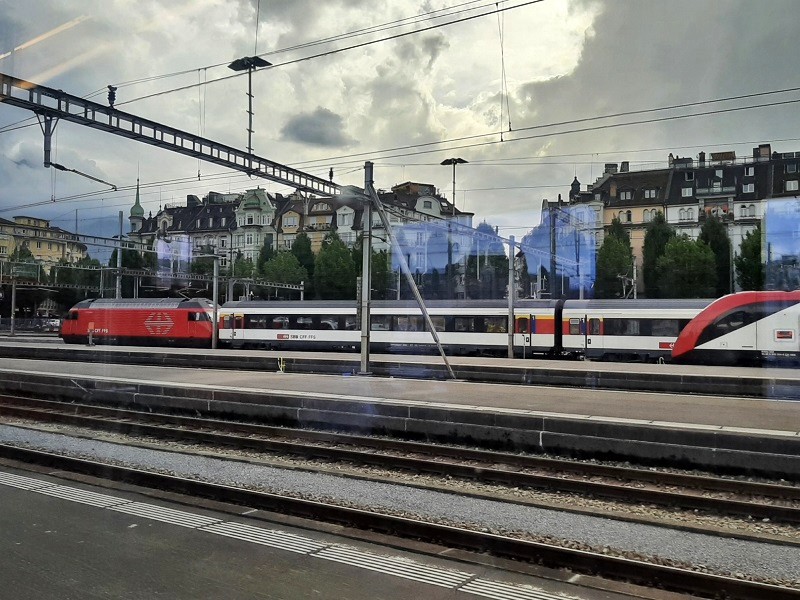

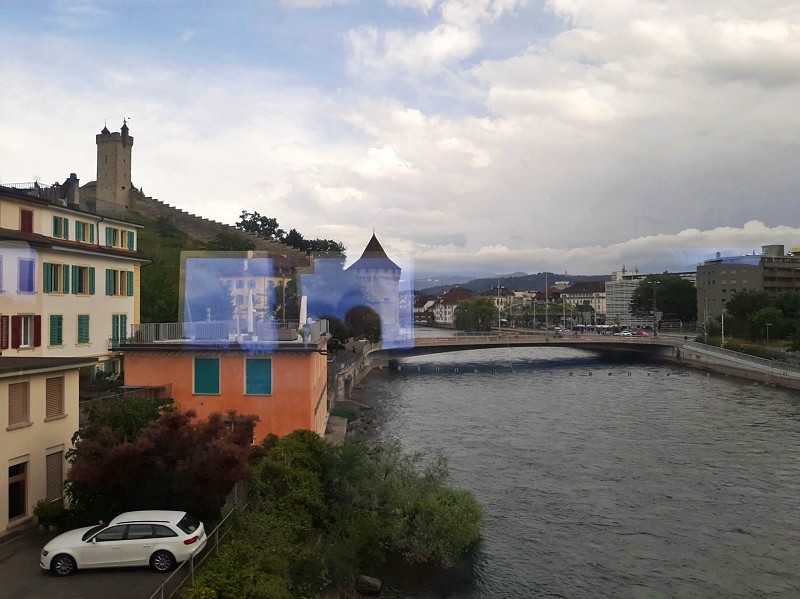

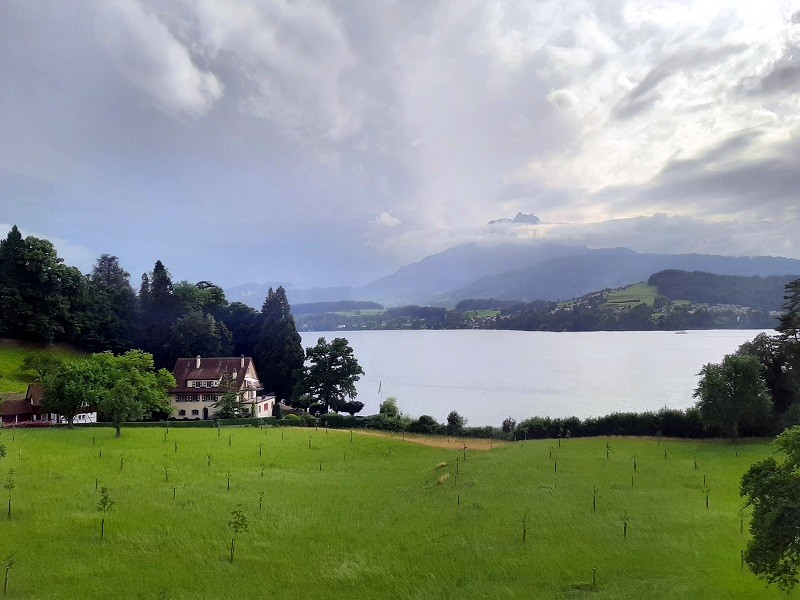
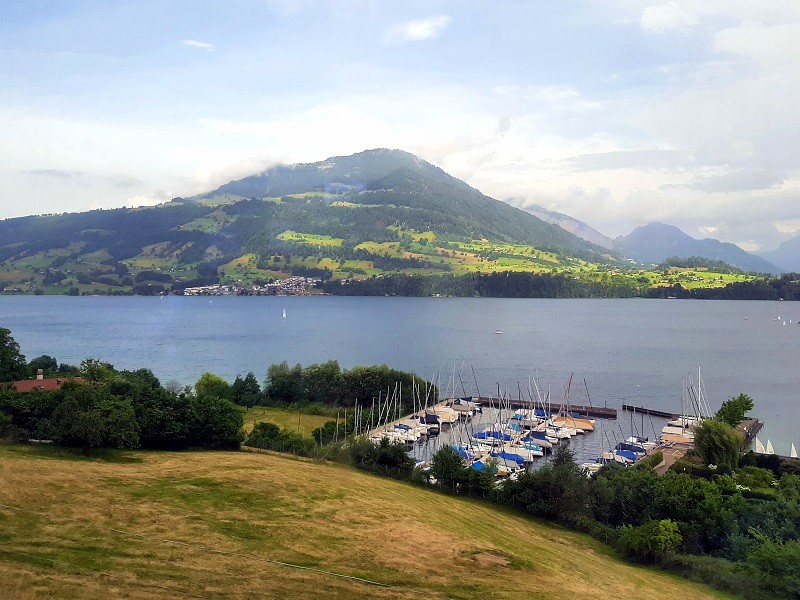

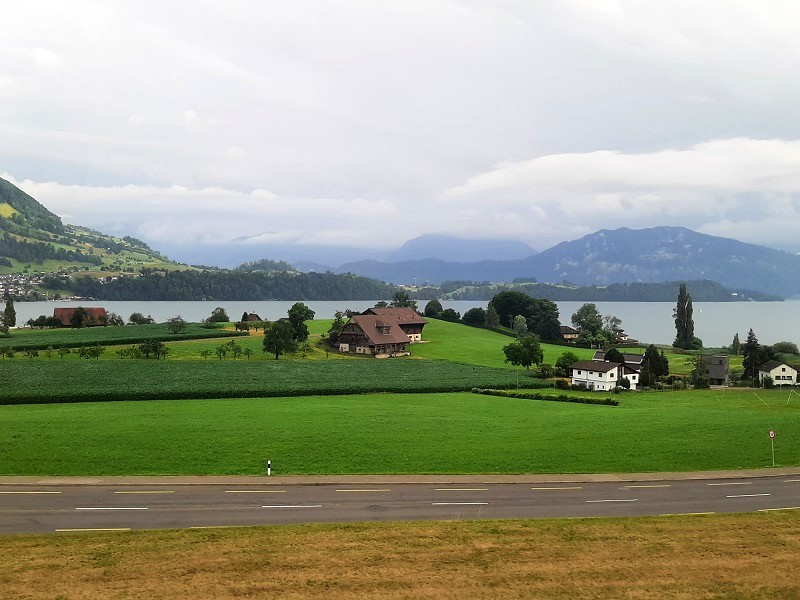
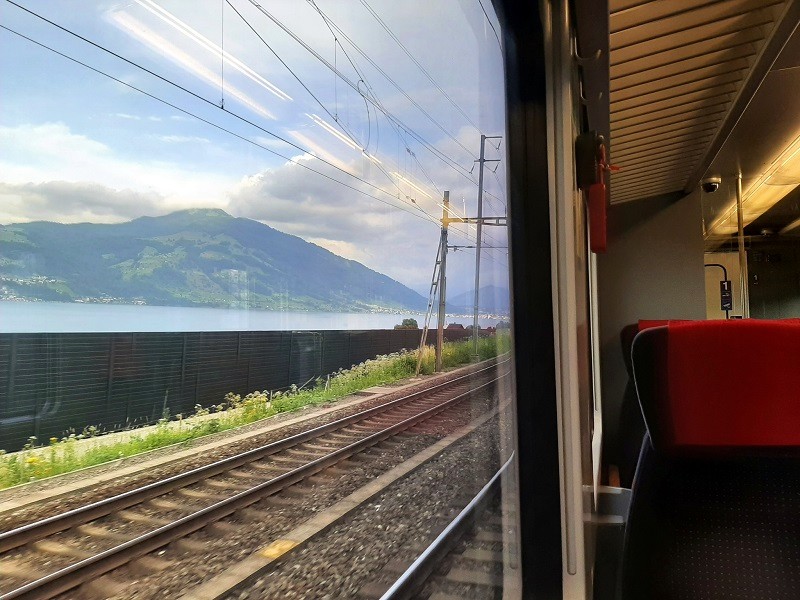
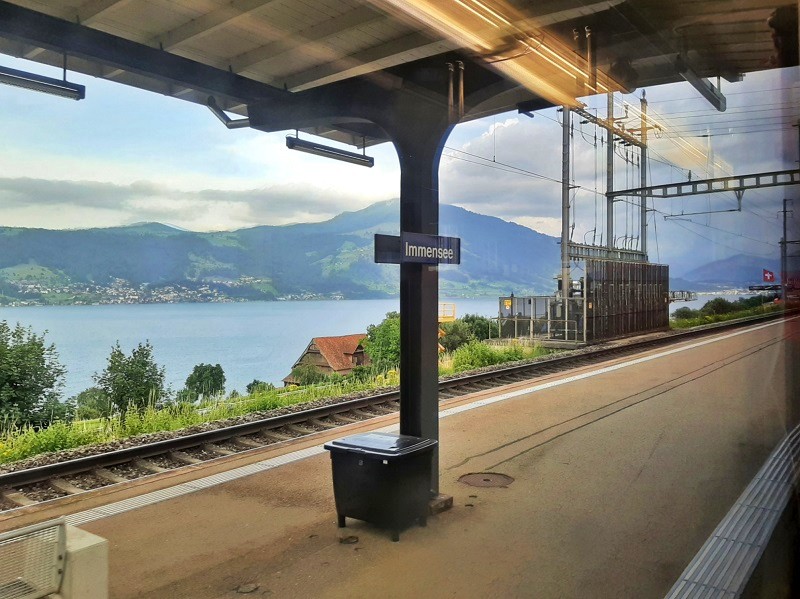
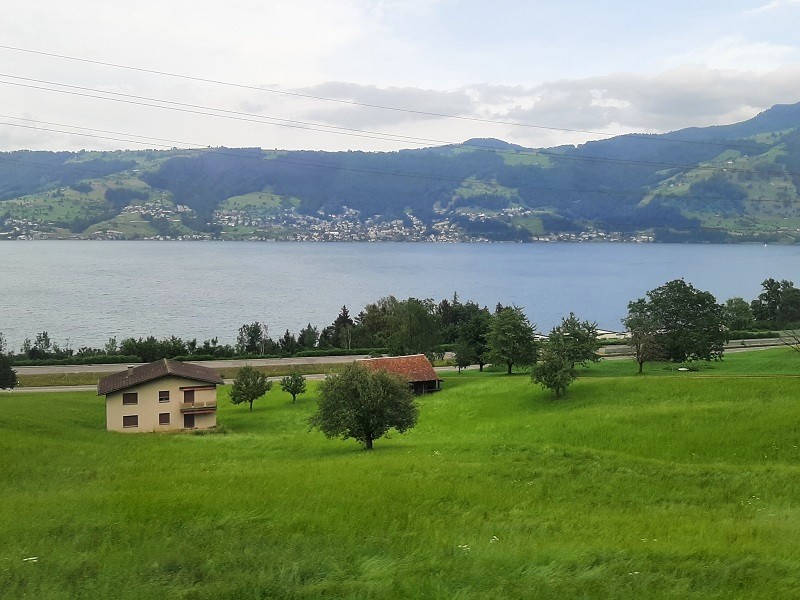
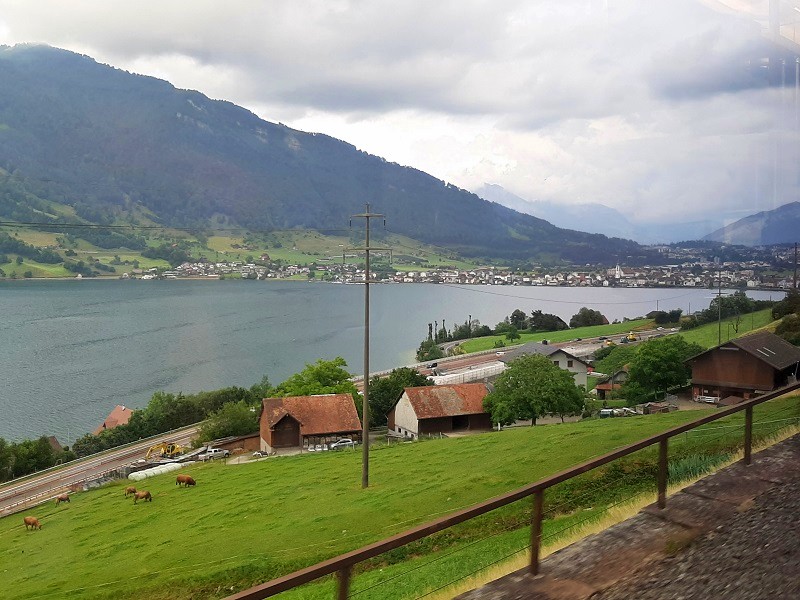
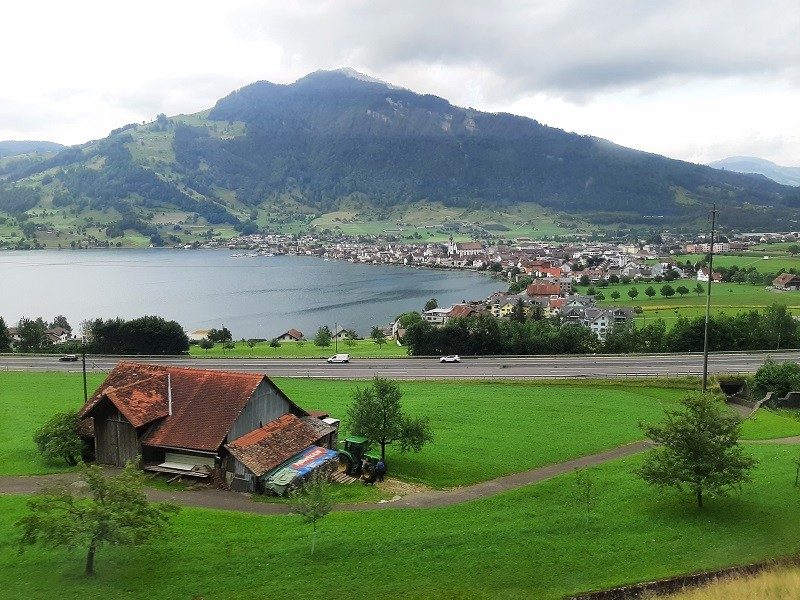
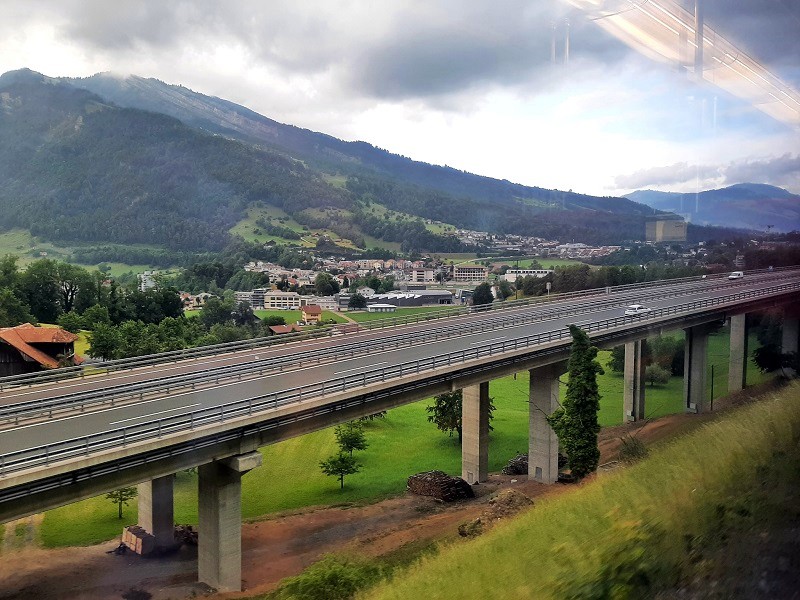
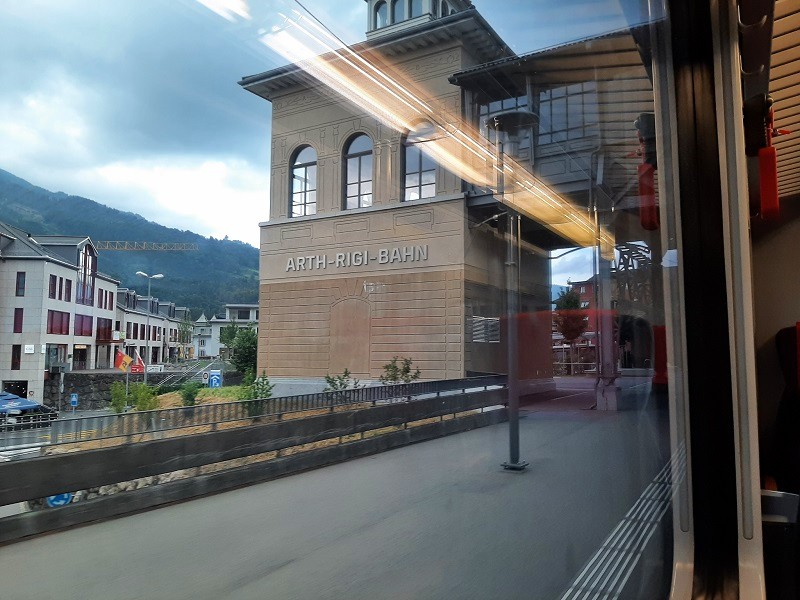
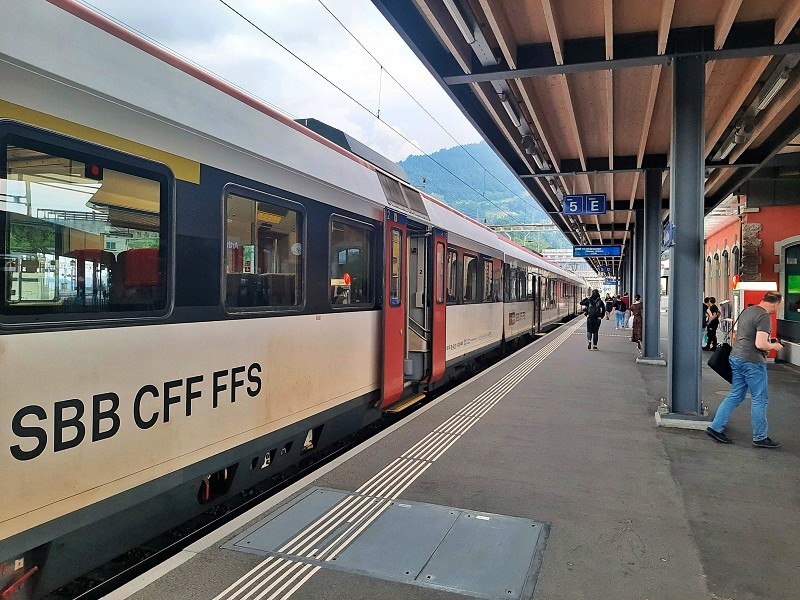
Changing trains in Arth-Goldau
Arth-Goldau was the first station where I needed to change trains on my journey from Lucerne to Locarno.
The station is located in the village of Goldau, but since it is part of the nearby town and municipality of Arth, it carries the combined name of Arth-Goldau.
Arth-Goldau is an important railway junction and interchange station where you can change for trains heading north to Zug and Zurich, west to Lucerne, or south across the Gotthard to Bellinzona.
It is also the terminus of the Arth–Rigi railway line, a scenic rack railway that takes you up Mount Rigi.
In case you still need to stock up on supplies for your train journey, you can find a handy Coop supermarket inside Arth-Goldau station.
After a short wait at the platform, my connecting train to Bellinzona arrived at Arth-Goldau station from Zurich, where it had started its journey across Switzerland.
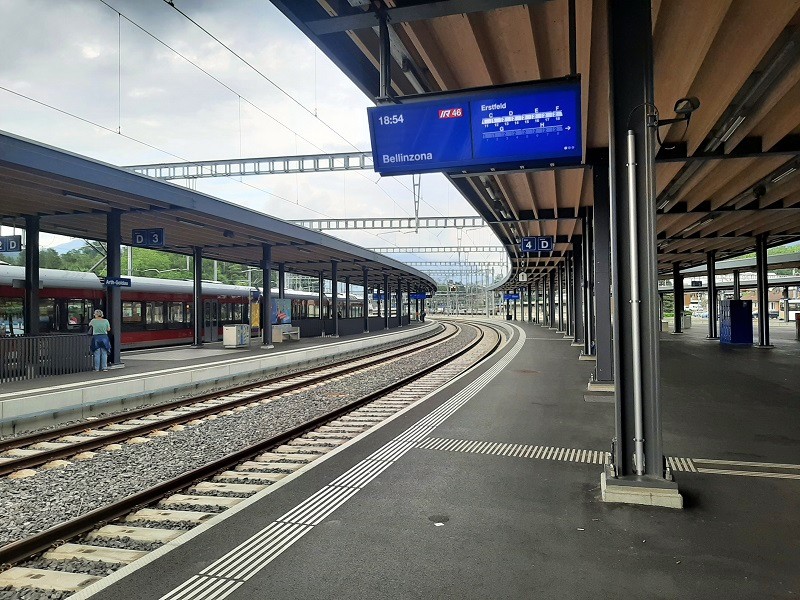
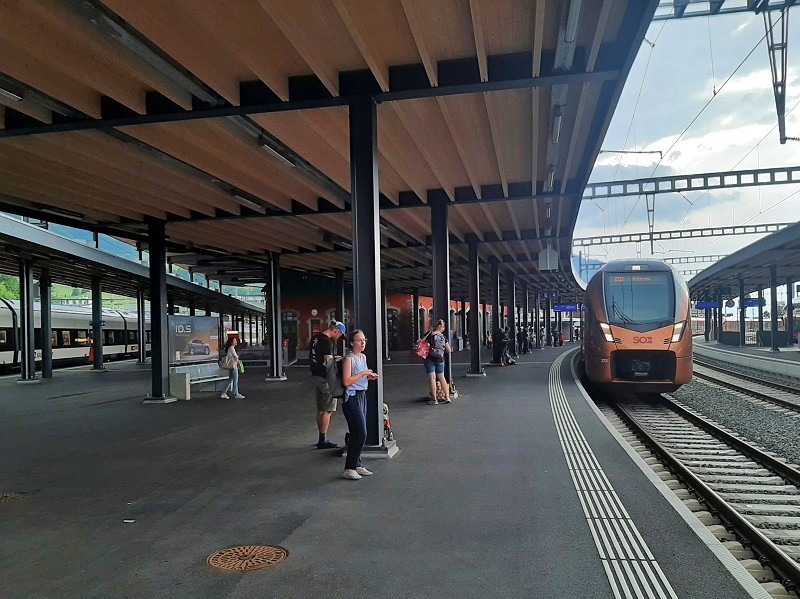
InterRegio trains on the Gotthard line
The InterRegio trains operating on the classic Gotthard line are jointly run by Swiss Federal Railways (SBB) and Südostbahn (SOB), and are referred to by the Italian name “Treno Gottardo”.
This InterRegio service is operated by modern EMU (electric multiple unit) trainsets known as Traverso trains, which can be easily identified by their distinctive copper-and-red livery.
The interior of these Traverso trains, built by the Swiss company Stadler, is sleek and modern, featuring comfortable seats in both travel classes.
Second class seats are arranged in a 2+2 configuration, while first class offers more comfortable seating in a more spacious 1+2 configuration.
Of course, you can expect power sockets in both travel classes.
These Traverso InterRegio trains plying the classic Gotthard line all feature a buffet corner with a vending machine and a coffee machine.
If you have been reading the other chapters of my Swiss scenic railways trip report, you might have noticed that the interior of these Traverso trains is remarkably similar to that of the BLS train between Zweisimmen and Spiez that I took earlier.
Although still a notch below InterCity or EuroCity trains in terms of on-board services, these Traverso InterRegio trains come very close in terms of comfort.
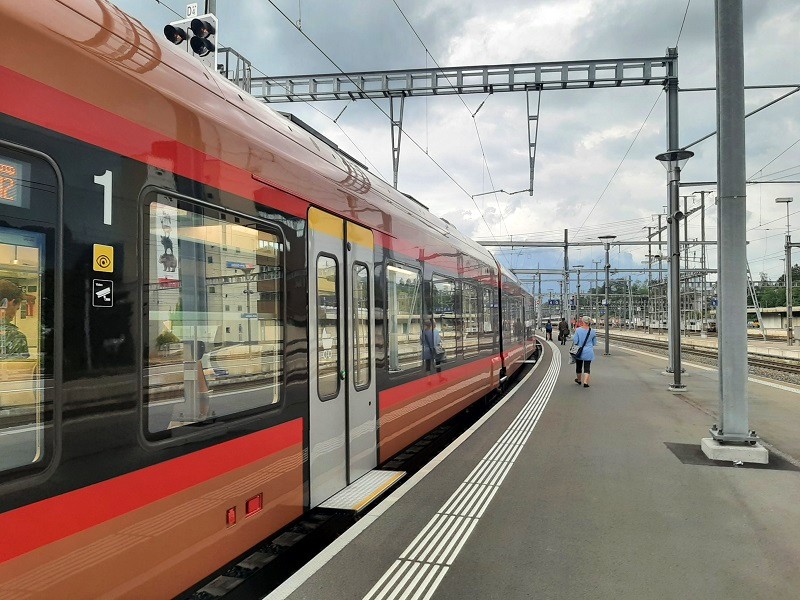



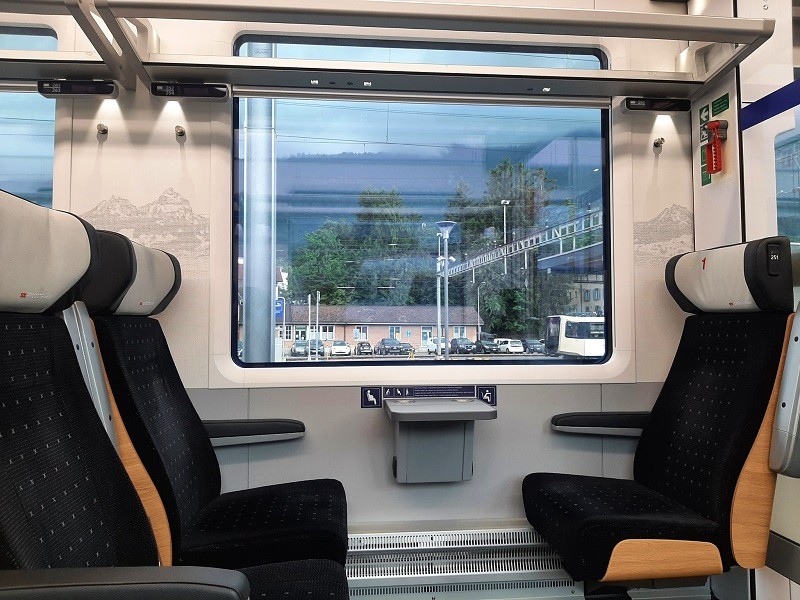
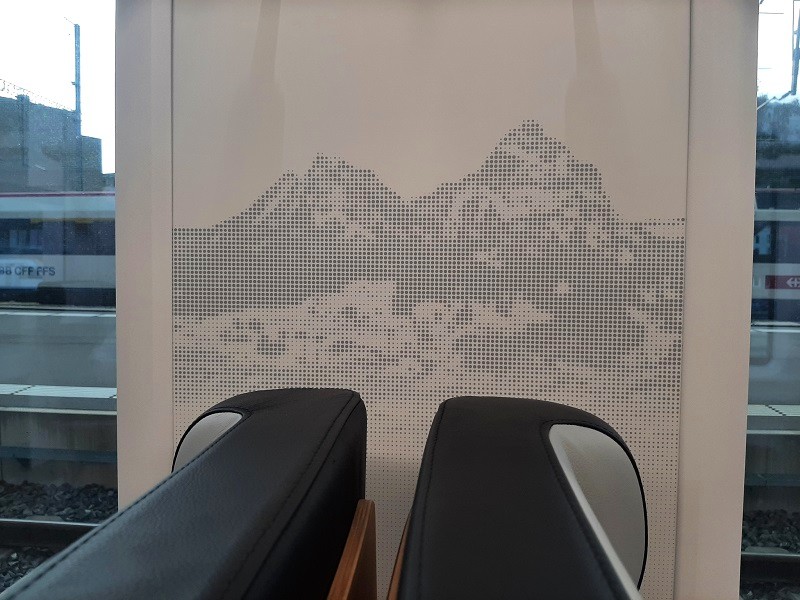
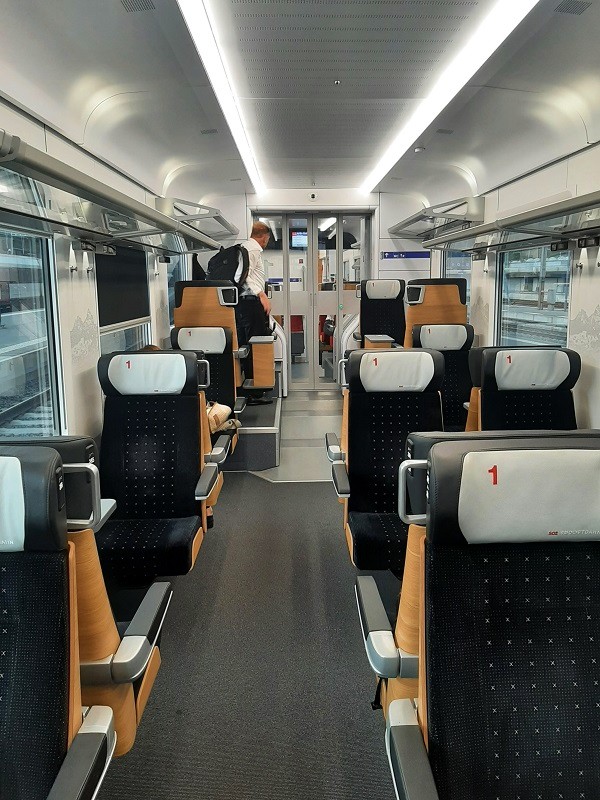
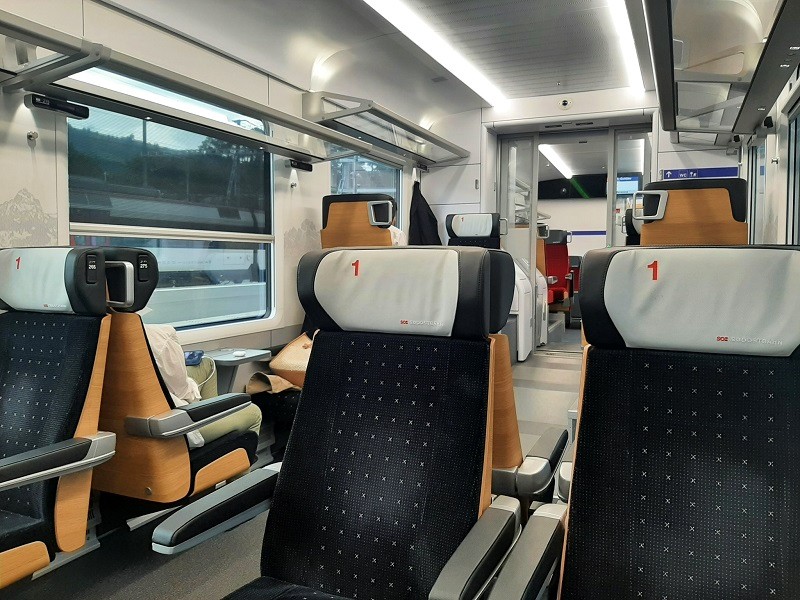
Arth-Goldau to Bellinzona by InterRegio Train
Train IR 2433 – Departure: 6.54pm – Arrival: 9.02pm
Duration: 2h08m – Distance: 141 kilometres
On the way to the Gotthard
From Arth-Goldau, my InterRegio train headed south towards the Gotthard Massif.
Just after passing through the town of Brunnen, the railway line runs parallel to Lake Lucerne once again for a while.
I cracked open a beer that I had brought along for the ride and savoured the distant mountain views across the lake.
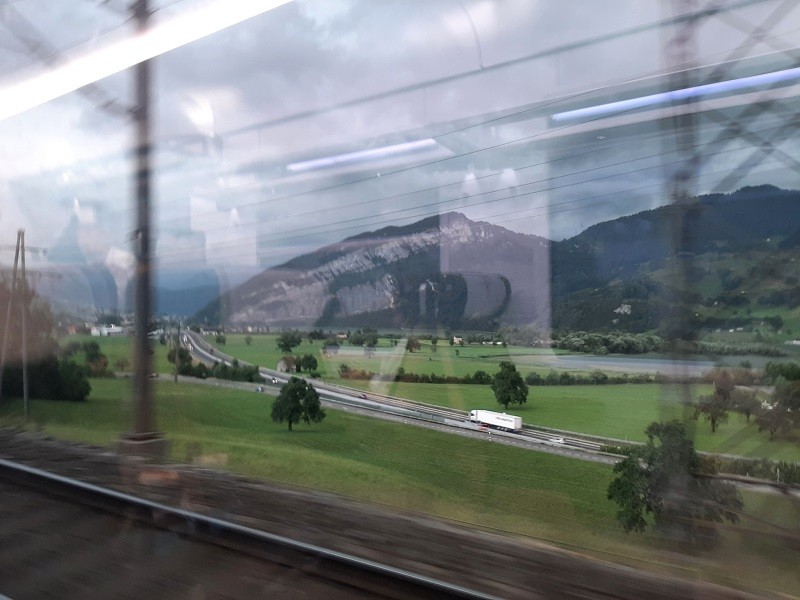


Weather conditions
So far, I had experienced mixed weather conditions on my scenic Swiss train rides, ranging from bright sunshine and mostly blue skies on the Bernina Express to cloudy weather on the GoldenPass Belle Époque from Montreux to Zweisimmen.
However, even on those rides with less-than-stellar weather, I was still able to enjoy the fabulous scenery that Switzerland has to offer.
This time around it was different, as dark storm clouds rolled in and a thick fog enveloped the lakes and valleys.
The combination of bad weather, approaching darkness, and the bright lights inside the train reflecting off the windows made it extremely difficult to see the beautiful scenery along the Gotthard railway line.
Occasionally, I would catch a glimpse of the stunning mountain scenery from one of the viaducts or spiral loops, but those moments turned out to be frustratingly brief.
I was optimistic that the weather would clear up once the train exited the old Gotthard tunnel and reached the southern side of the Alps at Airolo, but even there across the watershed, the weather turned out to be just as dismal.
As they say, you win some, you lose some, so I suppose I’ll need to try the classic Gotthard line again another time, hopefully in better weather.
We eventually arrived spot on time in a rainy Bellinzona, the final station of my train.
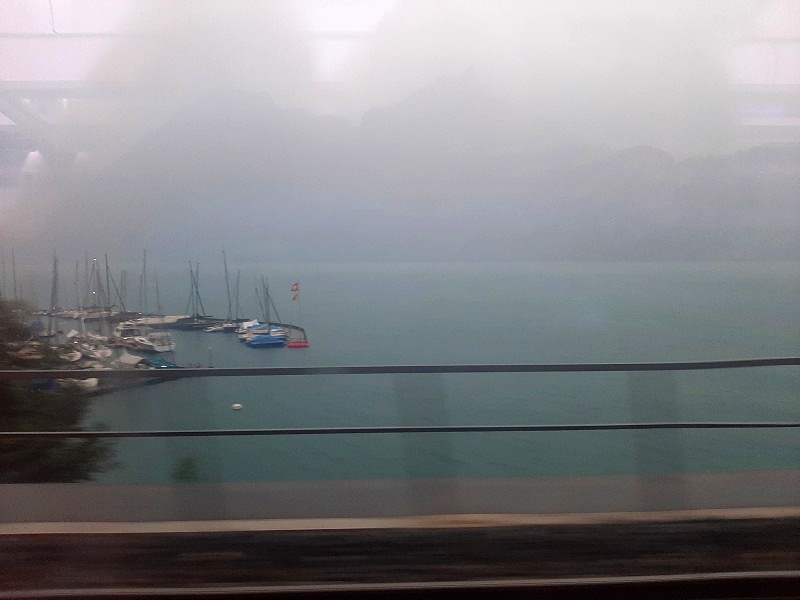
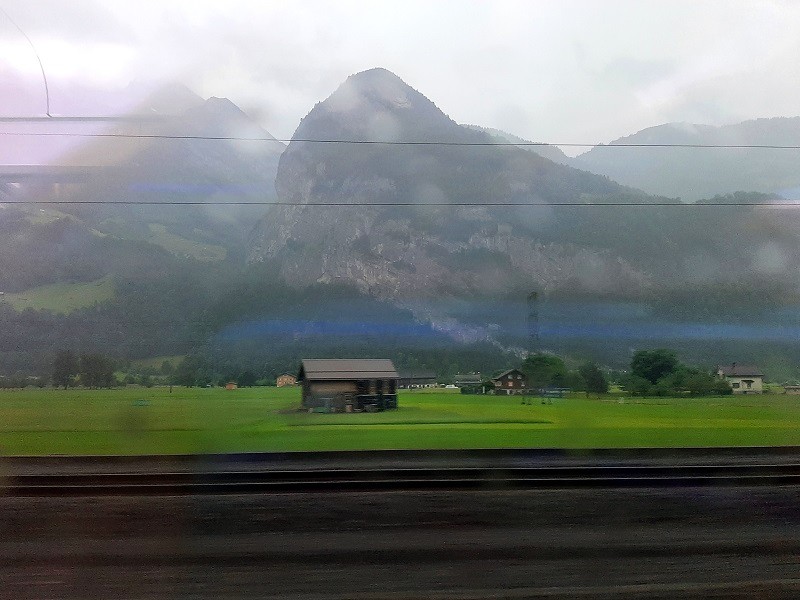
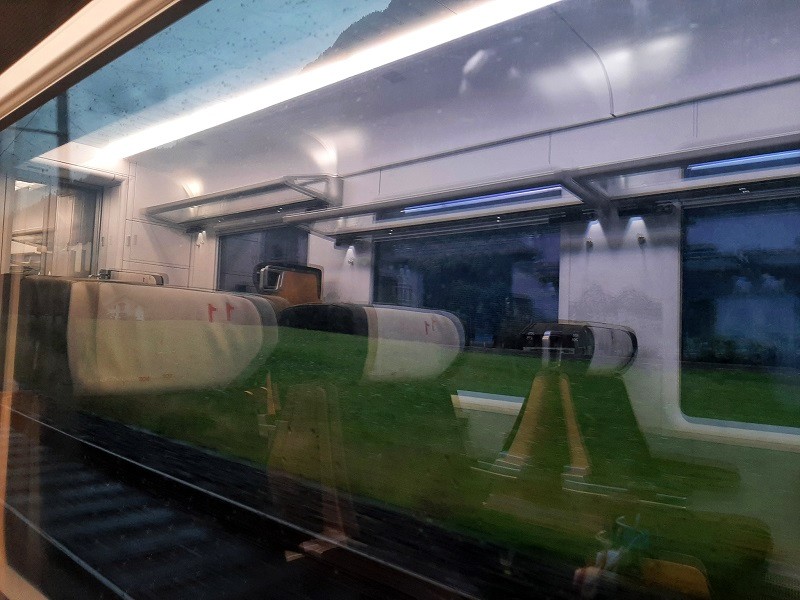
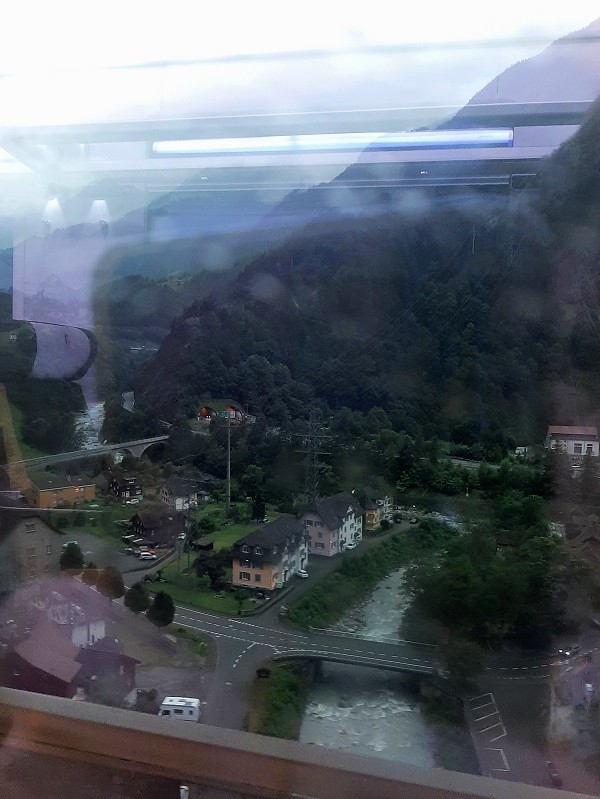
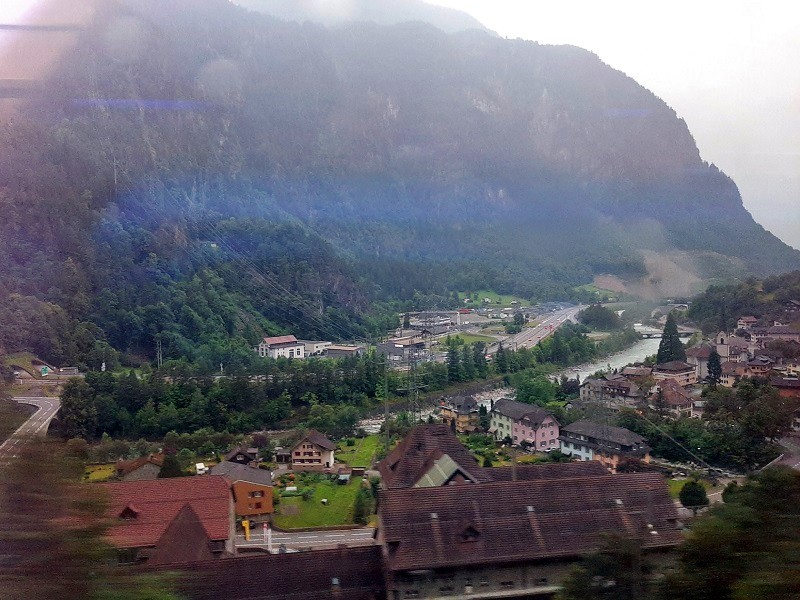
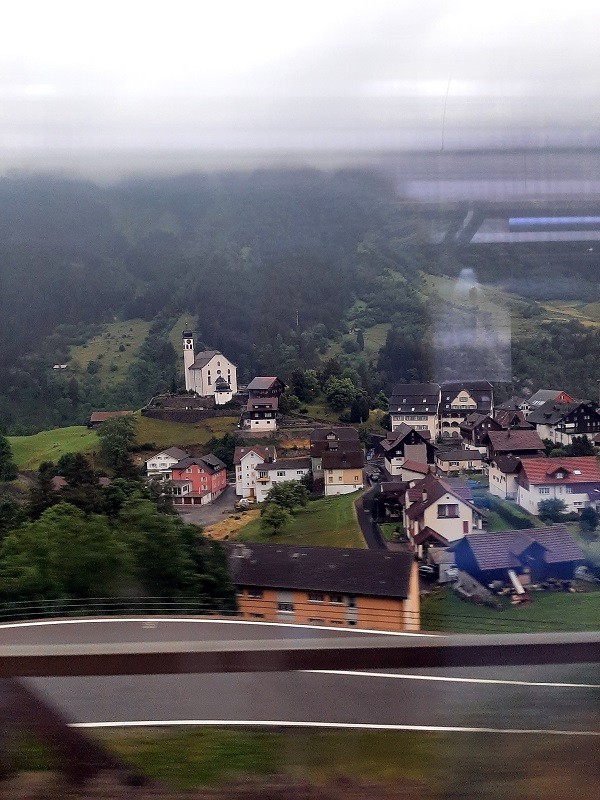
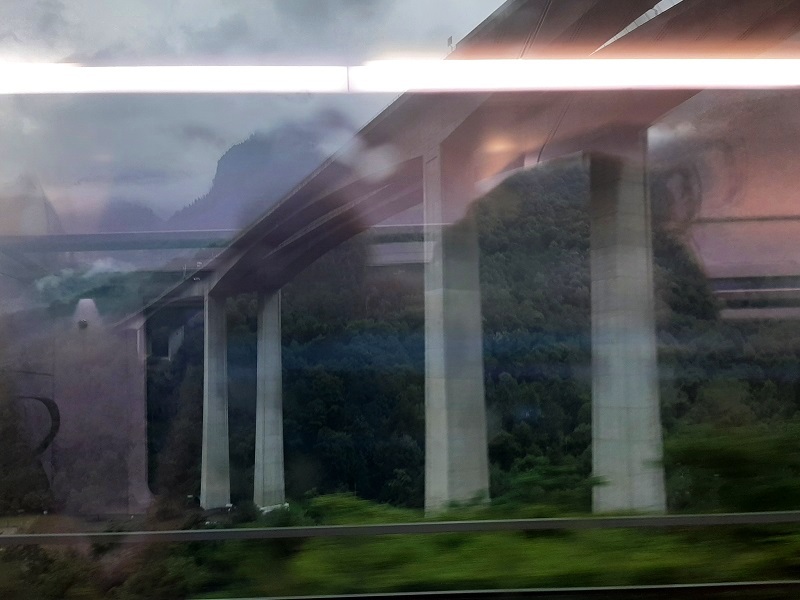
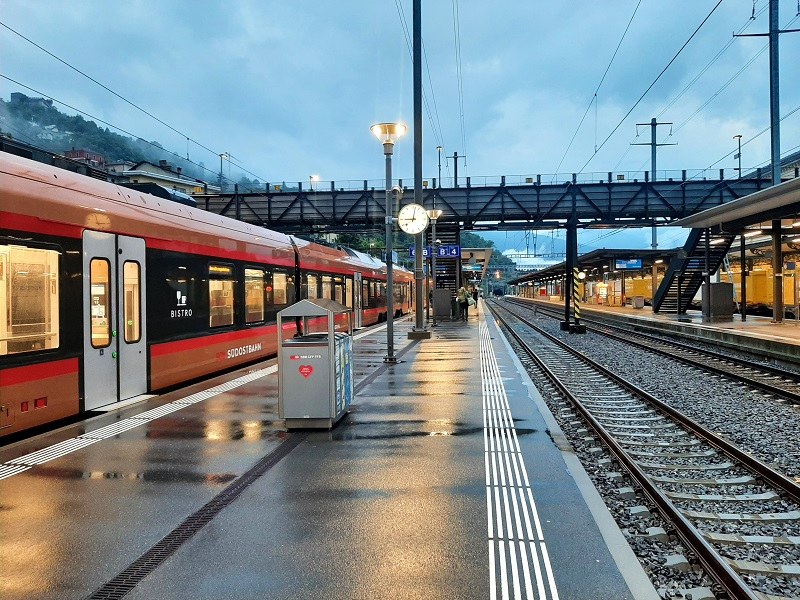
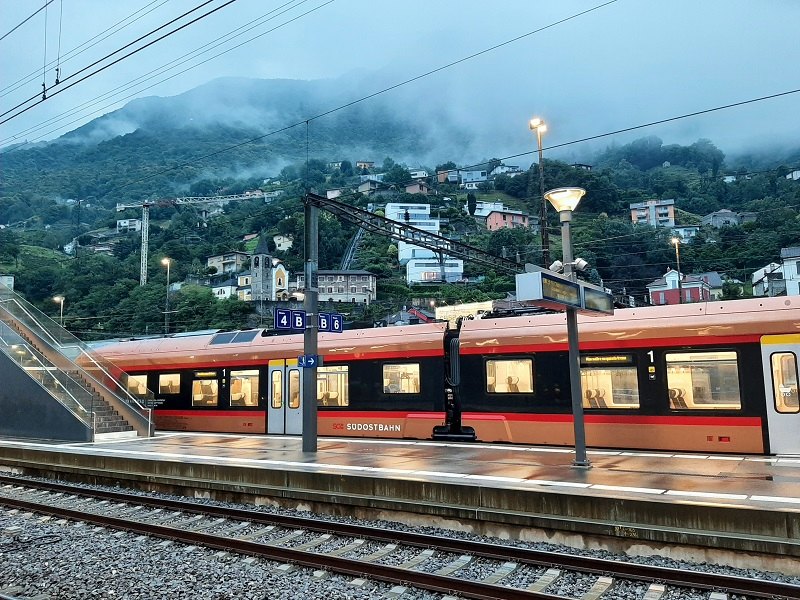
Changing trains at Bellinzona
At Bellinzona, the capital of the Italian-speaking Swiss canton of Ticino, I had to change trains once more.
Like the train from Lucerne to Arth-Goldau, an S-Bahn train would also carry me on the final stretch from Bellinzona to Locarno.
This train was operated by the regional transport company TiLo, which stands for Treni Regionali Ticino Lombardia, and is a joint venture between the Swiss Federal Railways and Italian railway company Trenord.
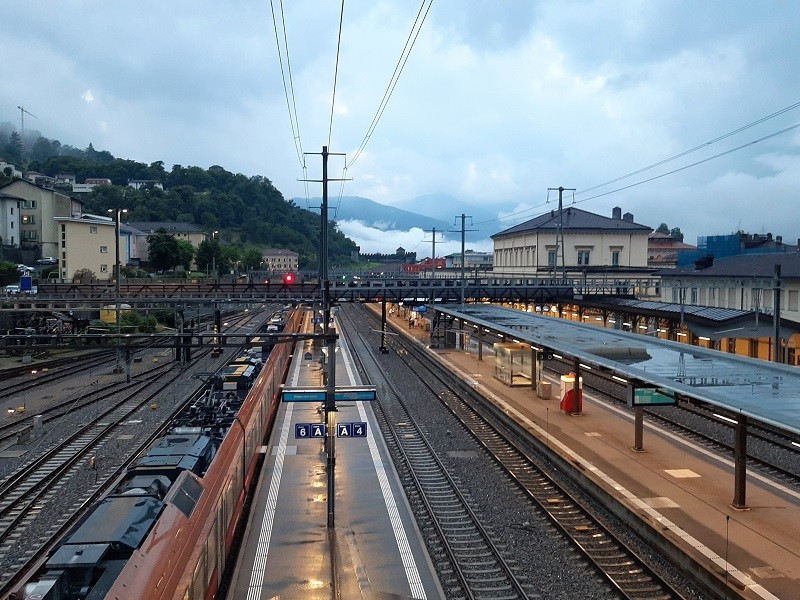
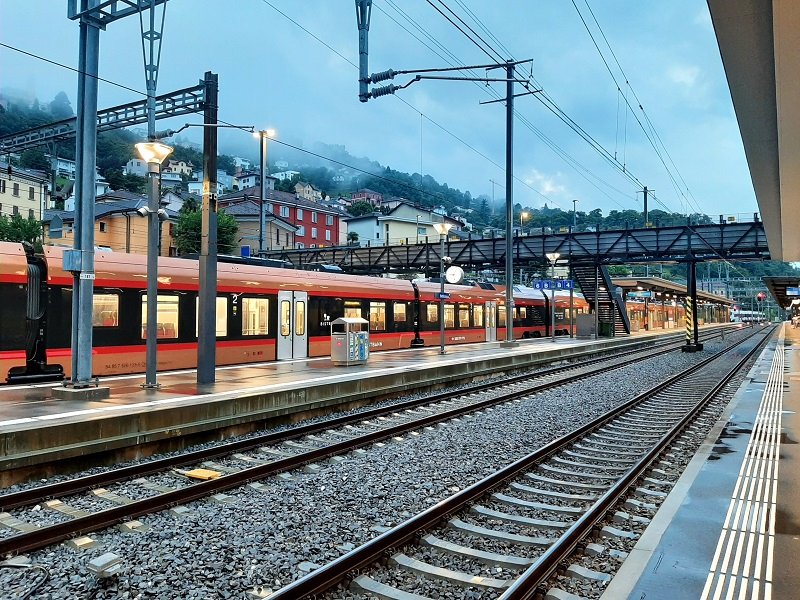
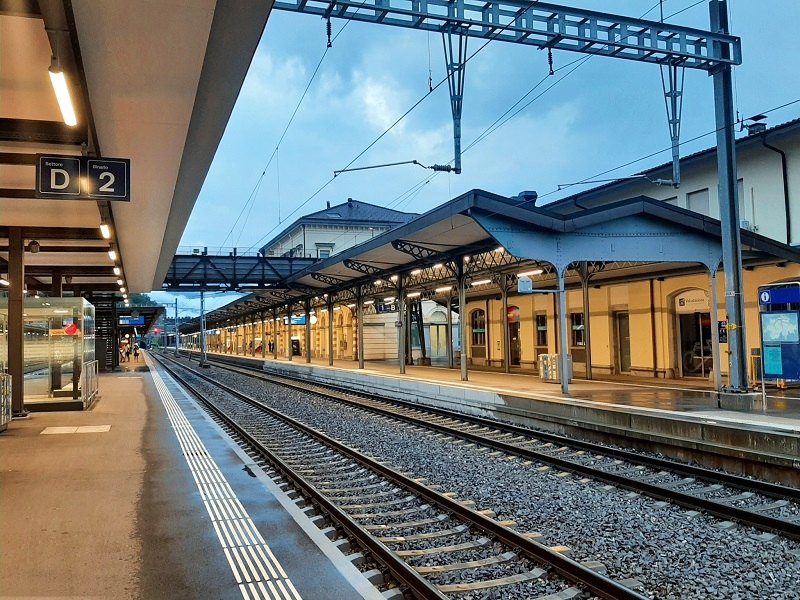
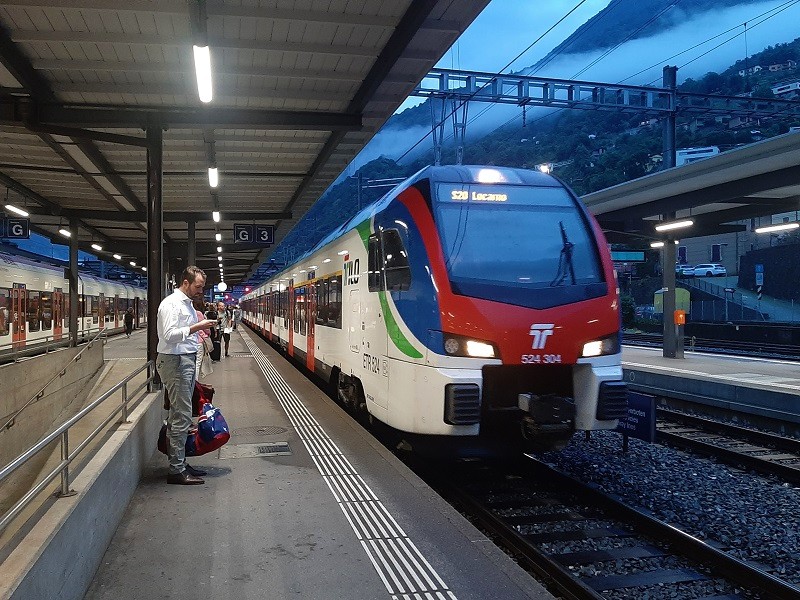
Bellinzona to Locarno by S-Bahn Train
Train S 25683– Departure: 9.19pm – Arrival: 9.44pm
Duration: 0h25m – Distance: 21 kilometres
My weird train ride to Locarno
The relatively short journey from Bellinzona to Locarno turned out to be the weirdest experience of all the train rides on this trip.
A young man roughly my age entered the first-class section of the train with a friend and started playing music from his phone extremely loudly while stamping like crazy on the floor.
His friend soon disembarked the train, but the man continued his obnoxious behaviour, which certainly seemed out of place in calm and peaceful Switzerland.
I gathered some my courage to address the issue, and, unable to speak Italian, I loudly told him in German to stop playing the music, as it seemed a more effective language for shouting commands and communicating my displeasure than English.
To my surprise, the man stood up and walked over to me, only to shake my hand and tell me that I shouldn’t complain, as the journey was only 20 minutes and we would soon arrive at our destination.
Relieved not to have been stabbed (given the rise in antisocial behaviour across Europe these days!), I decided it was best to let the issue drop.
However, after five minutes, the man returned to my seat and suddenly began to apologise profusely.
Almost in tears, the man explained that he had recently lost his father to cancer and his best friend in an accident, and needed to play music to help him cope.
He also spoke about other difficulties he had faced in recent years, mentioning that he had lost his job and some friendships during the pandemic and was only recently beginning to recover in both his professional and private life.
Upon disembarking the train in Locarno, he once again shook my hand firmly and thanked me for listening to him.
I still can’t excuse the man’s annoying behaviour on the train, but it reminded me that there is often a deeper reason behind someone’s actions and that the pandemic has had a profound impact on many people’s mental and economic well-being.
Fortunately, it was just a short walk from Locarno‘s railway station to my city centre hotel, where I could finally recharge my batteries after an intense journey.
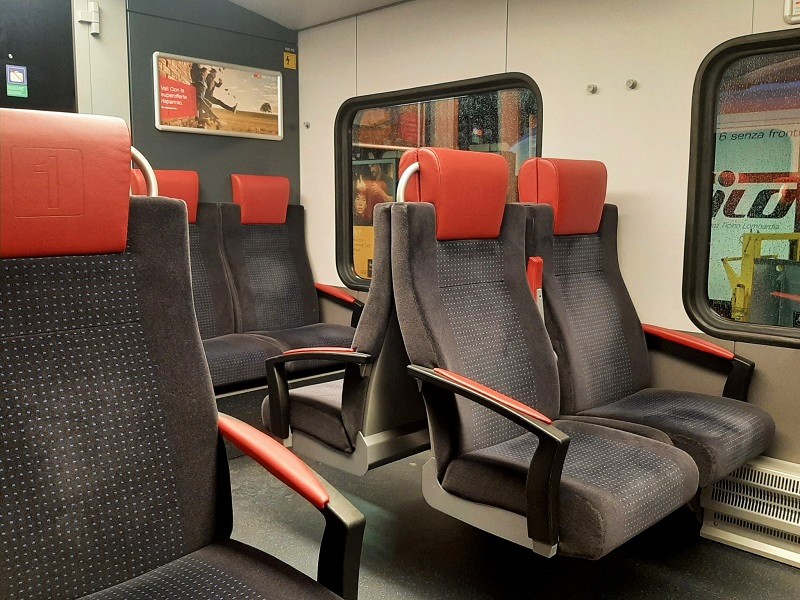
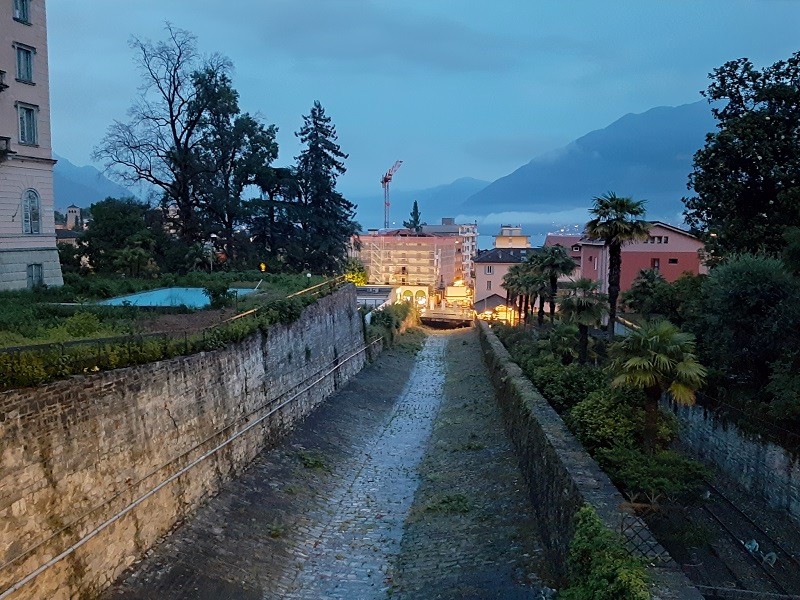
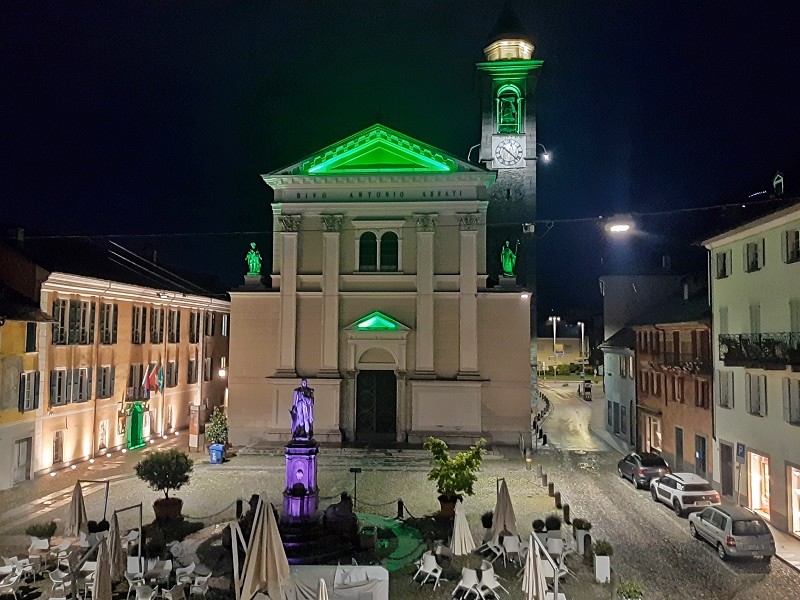
Conclusion
When travelling across the Swiss Alps to the Italian-speaking canton of Ticino, you can either take the classic Gotthard line or use the new railway line through the Gotthard Base Tunnel.
The classic Gotthard line, with all its viaducts and spiral loops, offers by far the most scenic rail journey, although taking a train through the new tunnel has the advantage of being twice as fast, as it bypasses most of the winding old railway line.
When I needed to travel from Lucerne to Locarno across the Gotthard, I chose to take one of the InterRegio trains that traverse the classic railway line.
I was impressed by the modern, comfortable Traverso trains used for the InterRegio service across the Gotthard.
Unfortunately, the weather was abysmal during my journey, so I still wasn’t able to fully enjoy the scenery along the Gotthard line.
Trip report index
This article is part of the ‘Scenic Trains Around Switzerland and the Italian Lakes‘ trip report, which consists of the following chapters:
1. Bergamo: A Visit to Lombardy’s Beautiful Hilltop Town
2. Travelling From Bergamo to Milan by Train
3. From Milan to Varenna and Tirano By Trenord Regional Train
4. A Varenna Visit: A Day Trip to Lake Como’s Most Beautiful Town
5. Tirano: The Italian Gateway to the Bernina Railway
6. Bernina Express Train: Guide to Switzerland’s Most Scenic Railway
7. Review: Swiss InterCity (IC) Train Chur to Zurich and Basel
8. From Zurich to Geneva on a Swiss ICN Tilting Train
9. Cheap Geneva Hotel: Stay Across the Border in Annemasse!
10. Around Lake Geneva by Train: From Geneva to Montreux
11. A Visit to Montreux and the Freddie Mercury Statue
12. Golden Pass: Guide to a Scenic Railway Route Across Switzerland
13. Swiss Chique: The MOB GoldenPass Belle Époque Train
14. From the Mountains to the Lake: Zweisimmen to Spiez by Train
15. Spectacular Spiez: A Visit to a Scenic Swiss Town
16. Spiez to Interlaken by Train: A Trip on the Lake Thun Railway Line
17. Review: Interlaken to Lucerne by Zentralbahn Train
18. Lucerne: Exploring One of Switzerland’s Most Beautiful Cities
19. From Lucerne to Locarno: By Train Across the Gotthard (current chapter)
20. A Visit to Locarno and the Sanctuary of Madonna del Sasso
21. Centovalli Railway: By Train From Locarno to Domodossola
22. Stresa: Grand Hotels, Lakeside Views, and the Borromean Islands
23. Review: Trenitalia Frecciarossa High-Speed Train Milan to Bologna

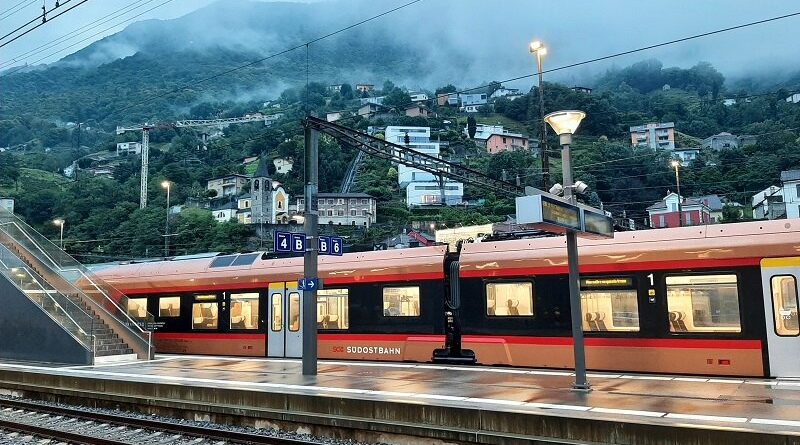
Do you hold an Interrail pass for all these trains or buy regular tickets? Also, what is the name of the accommodation in Locarno?, it has a beautiful view
I was travelling with an Interrail pass in hand, yes. A three-month pass actually, which I bought when they had an amazing 50% discount. I explained it further in the introduction of the trip report
https://paliparan.com/2023/02/14/switzerland-scenic-train-trip/
The hotel in question is Osteria Pozzo, a local restaurant which also rents out rooms on the upper floors. I’ll detail it in more depth in the next instalment of the series about Locarno!